|
BOOK & VIDEO REVIEWS
Some of the more significant Books and Video on Charlie Christian
are reviewed on these pages.
Scroll down
or
click on the title of the items listed in the following table
to read the reviews
BOOKS |
Book Title |
Author / Editor |
Publisher |
| The Best of Charlie Christian |
Wolf Marshall
(Author/Transcriber) |
Hal Leonard |
| Charlie Christian: The Definitive Collection |
Pete Billmann,
Jeff Jacobson,
Wolf Marshall
(Transcribers) |
Hal Leonard |
| Charlie Christian and The Deuce: A History of
Charles Henry Christian |
Anita Arnold (Editor) |
Black Liberated Arts Center |
| The Charlie Christian Photo Collection |
Anita Arnold (Editor)
Photos by Leo Valdes |
Black Liberated Arts Center |
| Legendary Times and Tales of Second Street |
Anita Arnold (Editor) |
Black Liberated Arts Center |
| Annual Review of Jazz Studies 6, 1993 |
Edward Berger,
David Cayer,
Dan Morgenstern, Lewis Porter (Editors) |
Institute of Jazz Studies at Rutgers |
| Annual Review of Jazz Studies 7, 1994-95 |
Edward Berger,
David Cayer,
Henry Martin,
Dan Morgenstern, Lewis Porter (Editors) |
Institute of Jazz Studies at Rutgers |
| The Guitar in Jazz: An Anthology |
James Sallis (Editor) |
University of Nebreska Press |
| Charlie Christian |
Peter Broadbent |
Ashley Mark |
| Solo Flight – The Story of the Seminal Electric
Guitarist |
Peter Broadbent |
Ashley Mark |
Additional information on the books and video is in “A Charlie Christian Bibliography” located in the
Bibliographies section
[ Home ]
[ News/Updates ] [ Solography ] [ Discography ] [ Chronology ] [ Photo Gallery ] [ Transcriptions ] [ Ancillary Transcriptions ] [ Bibliographies ] [ CD Reviews ] [ Book-Video Reviews ] [ SplicedTracks ] [ Links ]
BOOK REVIEWS
A review of two recent Charlie Christian transcription
books
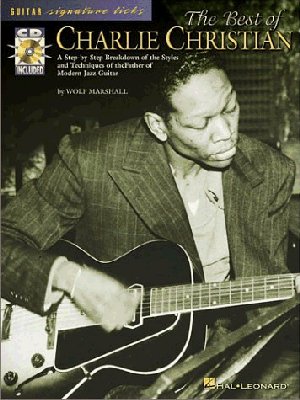 |
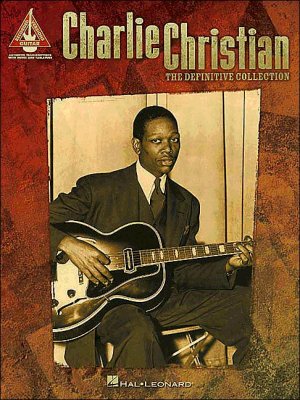 |
THE BEST OF CHARLIE CHRISTIAN
A Step-by-Step Breakdown of the Styles and
Techniques of the Father of Modern Jazz Guitar
by Wolf Marshall
Hal Leonard Corp.; 2002; 62 pages |
CHARLIE CHRISTIAN
THE DEFINITIVE COLLECTION
Music transcriptions by
Pete Billmann, Jeff Jacobson, Wolf Marshall
Hal Leonard Corp.; 2003; 128 pages |
1. Wolf Marshall’s The
Best of Charlie Christian
Wolf Marshall. The Best of Charlie Christian: A
Step-by-Step Breakdown of the Styles and Techniques of the Father of Modern Jazz Guitar.
Published 2002 by Hal Leonard in the series “Guitar Signature Licks.” 62
pp. book, with audio CD. $22.95
Wolf Marshall has produced an excellent collection of 15 CC
solos. Each transcription is accompanied by an analysis of its rhythmic, harmonic,
and melodic features. In the book there is also a CD, with recreations of the solos,
and some ensemble passages. Marshall has, on some titles, notated and commented on
introductions, head arrangements, riffs and ensemble passages as well as solos. The
book’s graphic design is good, and the music engraving is of a high standard, well
spaced on the page, and easy to read. A brief biography of CC is included, with some
interesting comments on the guitarist’s meeting with Barney Kessel (based on the
author’s interview with Kessel).
Published transcriptions generally fall into three categories:
the academic thesis or dissertation (e.g. Howard Spring’s work);
musicological books (e.g. Schuller’s The Swing Era); and sheet music
collections. Marshall’s book belongs to the last category, and joins a series
of publications the earliest of which is probably Edmonds & Prince’s The
Swingingest Charley Christian (1958).
We judge transcriptions by their accuracy, the quality of analysis, and
originality of approach. As can be seen from the transcriptions bibliography on this
website, hundreds of CC transcriptions have been published. Some of the most
interesting analyses tend to be difficult to obtain—e.g. Spring’s work is found
in an unpublished thesis and an academic periodical. For some people’s taste
Spring’s analyses are perhaps too lengthy. Wolf Marshall’s book has
achieved a good compromise; his comments are not overlong, yet they highlight many
points of interest.
He devotes about one page of commentary to each piece; his
observations are original and add to our enjoyment of the original solos. For
instance, in discussing “Shivers” he refers to the influence of Western Swing,
and identifies part of the solo that quotes from “Turkey in the Straw” and
“Arkansas Traveller,” melodies from this style of music. As promised in
the series title, Marshall often identifies CC’s favourite figures, and he gives
useful summaries of the format of compositions, e.g.:
“Benny’s Bugle is a standard
12-bar blues in B flat. The head is based on a two-measure riff melody moved through
the I, IV and V chord changes of a blues progression. The riff melody contains a
triadic bugle-type arpeggio outlining of each chord of the progression…”
The choice of solos for this volume is well judged. It includes a
variety of tempi, the ballad “Star Dust,” the slow tempo “A Smo-o-o-oth
One” (the correct spelling of which defeats the editor of this book as it does most)
through to the upbeat “Seven Come Eleven” and “Good Enough to
Keep.” It would be hard to omit “Solo Flight” from a collection of
CC’s best solos—Marshall obliges, and “Grand Slam” joins the record of
one of the most transcribed CC solos—16 versions at least. The version of
“Shivers” notated here joins only two previously published
transcriptions—Fox (1964) and Kuboki (1995). A “first” is the
appearance of take -1 of “A Smo-o-o-oth One”—a transcription of which has
not previously been published. If there is one addition I would like to have seen it
would be examples of CC's use of double time—for instance the perfectly poised
passages in solos on “Memories of You.”
Wolf Marshall and a small group strive to produce faithful recreations
on the CD. On “Solo Flight” Mike Tomaro has produced a very accurate
simulation of the original big band arrangement; it sounds as though he used a
sequencing program for this. Some of the pieces are more successful than
others: e.g. on “Star Dust” the guitar solo is very close to the original
in tone, phrasing, and articulation. The accompanying bass, drums and clarinet lines
towards the end of the solo are also very accurate. On “Seven Come
Eleven,” the head arrangement and clarinet solo over the middle eight are very
accurate, but the guitar solo sounds a little rushed, and some other titles have a similar
problem. It is possible that the accompanying musicians are from a rock or classical
background and hence their rhythmic feel is not quite authentic at times. However
these are minor criticisms, as overall these are very authentic recreations.
As far as the accuracy of notation is concerned, Marshall has been
conscientious about notating grace notes, articulations, bends, and slurs that are an
important element of CC’s style. His transcriptions also include
tablature; I assume that the tablature reflects how the solo would
“normally” be played (or perhaps might most easily be played). However, as
Leo Valdes has suggested in recent postings on this site, it is likely that CC often used
unconventional fingerings to achieve different timbre, or other effects, in his
solos. Others who have written about the soloist or notated his solos have not, to
my knowledge, appreciated this intriguing aspect of his style.
Some of the transcriptions in the book have been published
elsewhere. Marshall’s Best of Jazz Guitar (2000) is a collection of
transcriptions of various artists that has the same notation of “Honeysuckle
Rose” that appears in the present album. On his website, Marshall presents a
page—“Introduction
to the Charlie Christian Guitar Style”—that includes analysis of the same
versions of “Honeysuckle Rose” and “Benny’s Bugle” as in the
album reviewed. This site provides a useful preview of what you can find in the
printed version. (Further reproductions of notations in the album are to be found in
the next publication reviewed here.)
In summary, this is an attractively packaged collection of
transcriptions, notated very accurately, with interesting analysis. It can be highly
recommended for anyone wishing to study or enjoy the music of Charlie
Christian. —Clive Downs
2. Charlie Christian: The Definitive Collection
Hal Leonard. Charlie Christian: The Definitive
Collection. Transcriptions by Pete Billmann, Jeff Jacobson, &
Wolf Marshall. Published 2003 by Hal Leonard. 128 pp. book. $19.95
Another collection of CC transcriptions has been produced in this
album, which offers a contrast in style to Marshall’s album reviewed above.
There is no annotation or analysis in this publication, but several titles provide what
may be termed ‘continuous’ transcriptions: every bar of the performance is
notated (though not for every instrument) and thus gives a version of the performance that
is, in a sense, complete. For instance, on “Gone with ‘What’
Wind” we find the clarinet solo, piano solo, guitar solo, vibes solo, second clarinet
solo, first riff section, second riff section, and third clarinet solo, (all notated for
guitar). It is useful to have such ‘complete’ transcriptions, not least
because often the sextet arrangements were often quite complex. As in the Marshall
album, the graphic design and presentation of this publication are of very good quality.
It would have been helpful if the editors had made it easier to see
where sections (solos, riffs, theme, etc.) in the transcription begin and end (Marshall is
much clearer in this respect). It is sometimes quite difficult to follow the
sequence of sections, particularly when the number of staves changes during the notation
(this happens quite often).
Fifteen titles are included in this album, and of these, the first ten
that appear in Marshall’s book are reproduced (at least the notation of the CC solos)
here. The same version of “Solo Flight” is transcribed in both albums, but
with different notations (presumably the transcription in The Definitive
Collection
is by Pete Billmann or Jeff Jacobson). The remaining four titles from Marshall
(“Benny’s Bugle,” “I Found a New Baby,” “A Smo-o-o-oth
One,” and “Air Mail Special”) are omitted from The Definitive
Collection, but in compensation, four additional titles are
included—“Flying Home,” “Rose Room,” “Stompin’ at the
Savoy,” and “Topsy (Swing to Bop).” It is puzzling, given the
generally ‘completist’ approach of the album, that only three of the six guitar
solo choruses on “Stompin’ at the Savoy” are transcribed. The
notation of this title seems to be in a different font than those transcribed by Marshall,
so perhaps the transcriber is one of the co-authors.
In its own right this album is an excellent collection of
transcriptions that would be of interest to all who appreciate the music of Charlie
Christian. It is a pity that two-thirds of the notations are direct reproductions of
items that have been published elsewhere. Music publishers, whether audio or printed
music, often republish material in different formats. In this case, perhaps
untypically, Hal Leonard has added interesting new material to the republished solos, by
way of ensembles, solos on other instruments, and other material (at least one extra item
in each of the ten).
Sometimes the references to issued recordings are a little
misleading. “Air Mail Special (Good Enough to Keep)” on p. 2 refers to the
album Benny Goodman Sextet 1939/1941, but the version of this title transcribed
is clearly from the complete performance (on take -1), as issued on Masters of Jazz MJCD
75 or Columbia Legacy box set C4K 65564.
To sum up, The Definitive Collection is a well-produced
collection of transcriptions whose only drawback is the recycled notations—but the
added non-guitar solo material offsets this factor. Again, I would recommend this
publication to anyone wishing to study the music of CC. —Clive Downs
For reference I have added a comparative analysis of the 15
transcriptions in each volume in the Table below. |
Table: Comparison of transcribed sections in Marshall (2002)
& Hal Leonard (2003).
( Titles are in the order in which they appear in Marshall ) |
| Title |
Section |
No. of bars |
Marshall |
Hal Leonard |
Star Dust
2 Oct 1939
WCO 26134 A |
theme |
16 |
– |
✓ |
| vib solo |
16 |
– |
✓ |
| Guitar solo |
32 |
✓ |
✓ |
Seven Come Eleven
22 Nov 1939
WCO 26286 A |
intro |
12 |
– |
– |
| theme |
32 |
✓ |
✓ |
| Guitar solo |
32 |
✓ |
✓ |
| vib solo |
32 |
– |
✓ (gtr
riffs) |
| clt solo |
32 |
– |
– |
| theme |
16 |
– |
– |
Honeysuckle Rose
22 Nov 1939
WCO 26290 A |
intro |
4 |
– |
✓ |
| theme |
32 |
– |
✓ |
| clt solo |
32 |
– |
✓ |
| Guitar solo |
32 |
✓ |
✓ |
| tpt solo |
16 |
– |
✓ |
| clt solo |
8 |
– |
✓ |
| riffs |
8 |
– |
✓ |
| riffs |
32 |
– |
✓ |
Shivers
20 Dec 1939
WCO 26354 A |
intro |
4 |
✓ |
✓ |
| theme |
16 |
✓ |
✓ |
| clt solo |
8 |
– |
✓ |
| theme |
8 |
– |
✓ |
| vib solo |
32 |
– |
✓ |
| Guitar solo |
16 |
✓ |
✓ |
| clt solo |
8 |
– |
✓ |
| Guitar solo |
8 |
✓ |
✓ |
| riffs |
16 |
✓ (gtr chords) |
✓ (gtr chords) |
| riffs |
8 |
– |
✓ (gtr chords) |
| riffs |
8 |
– |
✓ (gtr chords) |
Till Tom Special
7 Feb 1940
WCO 26494 A |
intro |
4 |
– |
– |
| head |
32 |
✓ |
✓ |
| riffs |
16 |
✓ |
✓ |
| vib solo |
8 |
– |
– |
| riffs |
16 |
✓ |
✓ |
| Guitar solo |
16 |
✓ |
✓ |
| pno solo |
8 |
– |
– |
| Guitar solo |
8 |
✓ |
✓ |
| riffs |
16 |
✓ |
✓ |
| clt solo |
8 |
– |
✓ |
| riffs |
8 |
– |
✓ |
| tag end |
4 |
– |
✓ |
Gone with “What” Wind
7 Feb 1940
WCO 26495 B |
intro |
4 |
– |
✓ |
| clt solo |
20 |
– |
✓ |
| pno solo |
24 |
– |
✓ |
| Guitar solo |
24 |
✓ |
✓ |
| vib solo |
24 |
– |
✓ |
| clt solo |
24 |
– |
✓ |
| riffs (1) |
12 |
✓ |
✓ |
| riffs (2) |
12 |
✓ |
✓ |
| riffs (3) |
12 |
✓ |
✓ |
| clt solo |
12 |
– |
✓ |
Grand Slam
10 Apr 1940
WCO 26744 B |
intro |
8 |
✓ |
✓ |
| clt solo |
24 |
✓ |
✓ |
| Guitar solo |
24 |
✓ |
✓ |
| vib solo |
24 |
– |
✓ |
| pno solo |
24 |
– |
✓ |
| clt solo |
12 |
– |
✓ |
| riffs |
24 |
– |
✓ |
Six Appeal
11 Jun 1940
WCO 26940 A |
intro |
4 |
– |
✓ |
| head |
16 |
– |
✓ |
| Guitar solo |
16 |
✓ |
✓ |
| vib solo |
16 |
– |
✓ |
| clt solo |
16 |
– |
✓ |
| riffs |
16, 16, 14 |
– |
✓ |
| tag end |
4 |
– |
✓ |
Good Enough to Keep
(Air Mail Special)
13 Mar 1941
CO 29943-1
(Marshall p. 34) |
head |
32 |
– |
✓ |
| Guitar solo |
32 |
✓ |
✓ |
| clt solo |
32 |
– |
✓ |
| tpt solo |
32 |
– |
✓ |
| ts solo |
32 |
– |
✓ |
| riffs |
32 |
– |
✓ |
Wholly Cats
7 Nov 1940
CO 29027-1 |
intro |
4 |
– |
✓ |
| head |
24 |
✓ |
✓ |
| ts solo |
24 |
– |
✓ |
| pno solo |
24 |
– |
✓ |
| Guitar solo |
24 |
✓ |
✓ |
| clt solo |
24 |
– |
✓ |
| riffs |
24 |
– |
✓ |
| theme |
12 |
– |
✓ |
Benny’s Bugle
7 Nov 1940
CO 29030-1 |
intro |
4 |
– |
|
| head |
12 |
✓ |
|
| Guitar solo |
24 |
✓ |
|
| pno solo |
24 |
– |
|
| riffs |
12 |
– |
|
| ts solo |
24 |
– |
|
| riffs |
24 |
– |
|
| clt solo |
24 |
– |
|
I Found a New Baby
15 Jan 1941
CO 29514-1 |
intro |
6 |
– |
|
| theme |
32 |
– |
|
| Guitar solo |
32 |
✓ |
|
| pno solo |
32 |
– |
|
| tpt solo |
16 |
– |
|
| ts solo |
16 |
– |
|
| drm solo |
8 |
– |
|
| theme |
8 |
– |
|
Solo Flight
4 Mar 1941
CO 29865-1 |
intro |
8 |
– |
– |
| Guitar solo |
5 x 16 |
✓ |
✓ |
| clt solo |
16 |
– |
– |
| Guitar solo |
16 |
✓ |
✓ |
A Smo-o-o-oth One
13 Mar 1941
CO 29942-1 |
Guitar intro |
4 |
✓ |
|
| theme |
32 |
– |
|
| ts solo |
16 |
– |
|
| clt solo |
8 |
– |
|
| ts solo |
8 |
– |
|
| theme |
16 |
– |
|
| Guitar solo |
8 |
✓ |
|
| theme & tag |
8 + 2 |
✓ |
|
Good Enough to Keep
(Air Mail Special)
13 Mar 1941
CO 29943-2
(Marshall p. 57) |
head |
32 |
✓ |
|
| Guitar solo |
32 |
✓ |
|
| clt solo |
32 |
– |
|
| tpt solo |
32 |
– |
|
| ts solo |
32 |
– |
|
| riffs |
32 |
✓ |
|
Flying Home
2 Oct 1939
WCO 26132 A |
intro |
4 |
|
– |
| theme |
16 |
|
✓ |
| clt solo |
8 |
|
✓ |
| theme |
8 |
|
✓ |
| Guitar solo |
32 |
|
✓ |
| vib solo |
32 |
|
✓ |
| riffs |
16 |
|
✓ |
| clt solo |
8 |
|
✓ |
| riffs |
8 |
|
✓ |
Rose Room
2 Oct 1939
WCO 26133 A |
intro |
4 |
|
✓ |
| theme |
32 |
|
✓ |
| Guitar solo |
32 |
|
✓ |
| vib solo |
16 |
|
✓ |
| pno solo |
8 |
|
✓ |
| ens |
8 |
|
✓ |
Stompin’ at the Savoy
12 May 1941
Jam session at Minton’s |
theme |
32 |
|
✓ (gtr phrases) |
| tpt solo |
32 |
|
– |
| pno solo |
2 x 32 |
|
– |
| Guitar solo |
3 x 32 |
|
✓ |
| tpt solo |
3 x 32 |
|
– |
| Guitar solo |
3 x 32 |
|
– |
| tpt solo & tag |
32 + 4 |
|
– |
Topsy
(Swing to Bop)
12 May 1941
Jam session at Minton’s |
Guitar solo |
6 x 32 |
|
✓ |
| tpt solo |
4 x 32 |
|
– |
| pno solo |
2 x 32 |
|
– |
| Guitar solo |
3 x 32 |
|
✓ |
| tpt solo |
16, fade |
|
– |
| Details of the exact versions of each notated solo,
and albums on which the recordings are issued,
can be found in the Bibliography of Notated Solos on this
website.
Reviewed by CLIVE DOWNS |
© LeoValdes – 20 February 2004
CHARLIE AND
THE DEUCE
A HISTORY OF CHARLES HENRY CHRISTIAN
Edited by Anita G. Arnold
Black Liberated Arts Center, Inc.; 1994; 40 pages |
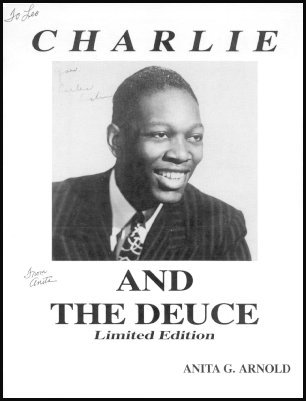
|
Ever since
the Charlie Christian Jazz Festival was inaugurated in 1984, it had been held during the
latter part of April or the first week of May. This year [1995] the 12th annual Charlie Christian Jazz Festival will
be held on July 29th, Charles’ 79th birthday anniversary, on the 300th block of N.E.
2nd Street in Oklahoma City. That block of “Deep
Deuce” was the center of activity during the time that Charles was
developing and working in OKC. Ruby’s Grill, where CC did much of his jamming,
was located in a two-story building that still stands right in the middle of the block.
Charles’ going-away party was held at Ruby’s Grill on Aug. 13, 1939,
before he left OKC the following day for his audition with Benny Goodman in Los
Angeles. It was also the site of a welcome-home jam on Jan. 11, 1940 during a
two-week vacation that CC took from the sextet. The Charlie Christian Jazz Festival
is organized by Black Liberated Arts Center (BLAC), Inc., 201 Channing Square, Suite 317,
OKC 73102, (405) 232-2522.
For last year’s [1994] festival, BLAC Inc. published an excellent 48-page, 8x11-inch souvenir book
entitled Charlie and the Deuce with lots of photos and info on CC and OKC. It
contains a couple of pages, gleaned from the “CHRONOLOGY”
chapter of my unpublished book, of Charles’ early history, events with the Goodman
band et al, and after. Available from Charlie’s Old Books and Records, 5114 N.
Classen, Oklahoma City, OK 73118, (405) 843-6902.
This year [1995] BLAC Inc. will be putting together a Charlie Christian photo album (with many
from my own collection of 60-some CC photos) for distribution at the festival.
This book review was originally
published in the 1995 Solo Flight: The Charlie Christian Newsletter # 1
© LeoValdes
Revised and updated on November 23, 2001 |
THE
CHARLIE CHRISTIAN
PHOTO COLLECTION
Edited by Anita G. Arnold
Black Liberated Arts Center, Inc.; 1995; 40 pages
All photos by Leo Valdes |
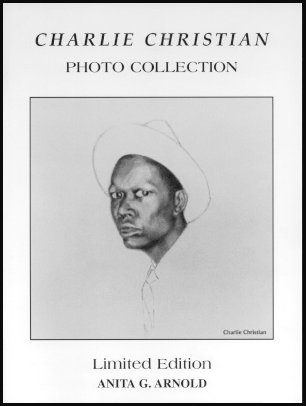 |
On the
79th anniversary of Charlie Christian’s birth (July 29, 1995), Oklahoma City held its
twelfth annual Charlie Christian Jazz Festival.
The most notable
event of this year’s festival was the publication and distribution of the photo album
mentioned in the review above. I had expected some of my photos to be published
along with others, but I was shocked to see that the entire album was put
together from my collection. About 70% of my stuff was in there along with my short
captions for each picture—verbatim except for a small typo on one with Charles
sitting in with Count Basie and his band at the Apollo.
I was pleased with the results though. Everyone must get a copy
of this soft-cover book—it’s the most complete collection of Charlie Christian
photos (close to 50) ever published. Many have never been in print before.
The period of time covered by my collection starts with a photo of
Charles at age three with his dog, Chubby, and ends with two photos taken at Charles’
funeral services held in Oklahoma City. (There were also services held for him in
New York City, Chicago and Bonham, Texas. The funeral in OKC was the largest the
state had seen up to that time.) The photo taken in front of the Calvary Baptist
Church shows Charlie Christian’s daughter, Billie Jean Christian, age 9,
standing at the top of the stairs with a light-colored bow in her hair.
There are also three
CC articles in the book: “The Advent of Charlie Christian”
by noted producer John Hammond; “Guitarmen, Wake Up and
Pluck!” by Charlie Christian; and “The
Charlie Christian Story” by the preeminent writer, Ralph Ellison.
Previously published in Down Beat, August 25, 1966, Down Beat, December 1,
1939, and The Saturday Review, May 17, 1958, respectively, they are required
reading.
According to BLAC Inc, the organization that put the book together, the
THE CHARLIE CHRISTIAN PHOTO COLLECTION is available from Charlie’s (Nicholson)
Old Books and Records, 5114 N. Classen, Oklahoma City, OK 73118, (405) 843-6902.
This book review was originally
published in the 1996 Solo Flight: The Charlie Christian Newsletter # 2
© LeoValdes
Revised and updated on November 23, 2001 |
LEGENDARY TIMES
AND
TALES OF SECOND STREET
Edited by Anita G. Arnold
Black Liberated Arts Center, Inc.; 1995; 50 pages |
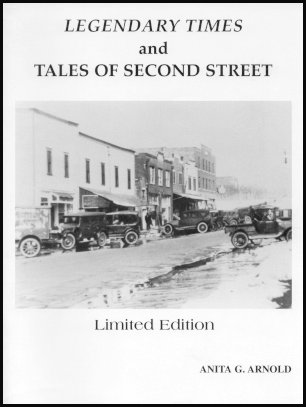 |
Another
publication put out by BLAC Inc for last year’s jazz festival was Legendary Times
and Tales of Second Street. “This book represents
reflections of memorable times, experiences, people and places associated with historical
Second Street in Oklahoma City.” Well worth getting; also available from
Charlie Nicholson’s.
This soft-cover contains three more photographs from my collection.
One has Charlie Christian sitting at a table with Count Basie, Ernie Fields, Melvin
Moore, and Jimmy Rushing. Another is the [December
1939] photo used in the JazzTimes [September 1995] article on the front page of this
newsletter [CC at the Waldorf-Astoria posing with an
ES-150]. The third was taken in 1923 of Charles and his
first-grade class at Douglas School, Oklahoma City (originally published with Ralph
Ellison’s The Saturday Review story—Ellison’s younger brother,
Herbert, was in the same class as Charles).
This book review was originally
published in the 1996 Solo Flight: The Charlie Christian Newsletter # 2
© LeoValdes
Revised and updated on November 23, 2001 |
ANNUAL REVIEW OF
JAZZ STUDIES 6
1993
Edited by
Edward Berger, David Cayer, Dan Morgenstern, Lewis Porter
Scarecrow Press
for the
Institute of Jazz Studies at Rutgers–The State University of New Jersey
1993; 304 pp; $39.50 |
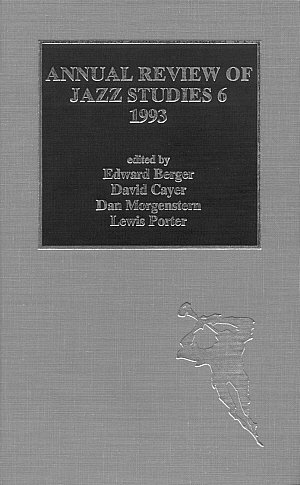 |
The sixth
volume of the Annual Review of Jazz Studies was published in hardcover format and
contains two significant articles on Charlie Christian. One presents a detailed
bibliography of his transcribed solos, the other examines his after-hours recorded
sessions in Harlem (Minton’s) and Minneapolis (Harlem Breakfast Club).
There’s also a one-page review by Lewis Porter of Charlie
Christian: The Art of Jazz Guitar, a 32-page softcover book of transcriptions
edited by Dan Fox. This book contains twelve “fairly
accurate” CC solo transcriptions from his studio recordings with Goodman. It
was originally published in 1964 and reprinted in 1988.
Clive Downs’
excellent treatise, “An Annotated Bibliography of Notated Charlie
Christian Solos,” documents all publications containing
transcribed solos of CC’s recordings. Extensive research was done in locating
almost fifty different publications that contain CC transcriptions—it includes all
(even those that are out-of-print) that I know of and many that I had not been aware of
previously. I was very impressed by the quality and comprehensive detail of his
work.
One section lists the publications with a complete description and
identifies every solo, with brief discographical information, included in each.
Another section lists each transcribed solo alphabetically by title and
provides an analysis of each transcription. Relevant information, such as
completeness, annotations, chord symbols, and key, are noted.
In addition to the two main sections, there is further discussion on
solo transcriptions in general and on Charlie Christian in particular.
Very well done and very comprehensive. I’m proud to say that
I contributed to this work with a few minor suggestions. Unfortunately for me, since
Downs’ article covers only published works, my own compleat Charlie
Christian transcriptions (close to 200 titles complete with solos, intros, riffs, tags,
etc.) are not included.
The major
transcription collections listed by Clive Downs are by Stan Ayeroff, Hank Edmonds &
Bob Prince, Dan Fox, Howard Spring, and Masayuki Takayanagi. There’s also a
collection of 16 transcriptions for a 1982 thesis at Duquesne University by Mark Antonich
but these are derived from previously published sources and can be disregarded. Even
Antonich’s narrative appears to be lifted verbatim from various books and articles.
Freelance Music also has a set of 23 transcriptions but they are poorly photocopied
and many are identical to the Dan Fox assemblage.
Stan Ayeroff’s 18 transcriptions are the best-packaged of the lot,
part of The Jazz Masters Series that is still readily available from Consolidated Music
Publishers. Dan Fox’s twelve and Edmonds & Prince’s four from
Minton’s & Monroe’s are in thin softcovers, also nicely done. The
accuracy in all three books is fairly good and well worth a look, especially at the
nominal price.
Howard Spring’s 1980 thesis for York University is the largest
collection with fifty transcriptions. Although a bit sloppy and hard to read, his
work is original and accurate. He didn’t transcribe the more difficult solos,
but on those he did, he transcribed the difficult passages exceptionally well—better
than the pros mentioned in the last paragraph. There are some errors here and there
and a couple of times he has a problem with the correct key, but they are very good
transcriptions with an extensive analysis of Charlie Christian’s
improvisational style. (The analysis looks good—I have yet to read it
all, let alone evaluate his analysis.)
The best
work by far, however, was done under the supervision of Masayuki Takayanagi.
Their dozen transcriptions are excellent—the most accurate I’ve seen.
Some appear to be duplicates of my own work which, of course, they couldn’t
have copied. The chord names are very exact as well. There’s even a
complete score of “Honeysuckle Rose” by the full band.
I only wish I could read Japanese so I could enjoy the narrative in the first part
of the book.
This consummate work by Clive Downs is excellent reference material for
anyone with cause to look for transcriptions of Charlie Christian’s solo work.
It’s very informative and, with its well-configured format, very handy.
[Clive Downs' bibliography can now be
found updated in the Bibliography section on this site]
Clive Downs’
34-page chapter is reason enough to buy the book but there’s also another compelling
chapter entitled “Charlie Christian, Bebop, and the Recordings at
Minton’s” by Jonathan Finkelman with partial CC
solo transcriptions.
In this 17-page chapter, Finkelman discusses Charlie Christian’s
pivotal role in the transition of the music from swing to bebop. In his analysis of
CC’s style, he uses examples of the guitarist’s commonly-used phrases (“formulas” or “licks”) not only from the jam
sessions at Minton’s (recorded by Jerry Newman in May 1941) as the title
suggests, but also from the after-hours session at the Harlem Breakfast Club (recorded by
Jerry Newhouse on September 24, 1939) in Minneapolis, which was briefly described
in my previous newsletter. These phrases are compared to some from Charles’
work with the sextet.
I agree with Finkelman’s cogent analysis and found it to be very
interesting. He ends his essay with source references, a bibliography, and selected
discography. A good piece of work that I enjoyed very much. Jonathan
Finkelman’s writing is highly recommended as one of the better analyses on
Charlie Christian’s style—a valid and succinct evaluation.
The entire volume 6
of Annual Review of Jazz Studies is recommended. There are several book
reviews in addition to the one on the Dan Fox book (which is reviewed as part of The Hal
Leonard Artist Transcription Series) plus eight other chapters on various subjects.
This book review was originally
published in the 1996 Solo Flight: The Charlie Christian Newsletter # 2
© LeoValdes
Revised and updated on November 23, 2001 |
ANNUAL REVIEW
OF JAZZ STUDIES 7
1994-95
Edited by
Edward Berger, David Cayer, Henry Martin,
Dan Morgenstern, Lewis Porter
Scarecrow Press
for the
Institute of Jazz Studies at Rutgers–The State University of New Jersey
1996; 283 pp; $39.00 |
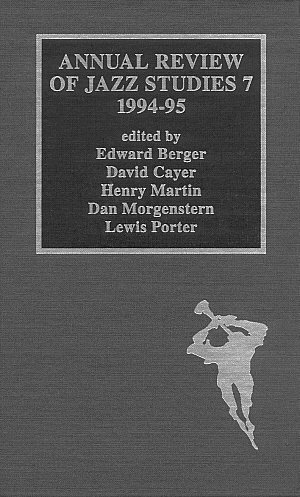 |
The
seventh volume of the Annual Review of Jazz Studies contains a most entertaining
and informative chapter on Charlie Christian by Jerome S. Shipman. “In Search of the Electric Guitar: A Platonic Dialog With Music” is a
tongue-in-cheek conversation between a Famous Jazz Critic (FJC) and an Interested Listener
(IL) that hypothetically takes place after a lecture by the FJC at a small liberal arts
college. The subject of the discussion concerns the early musical influences on
Charlie Christian. Leonard Ware, Eddie Durham, and Django Reinhardt are mentioned, but the
better part of the article concentrates on the influence of Western Swing. Specific solos
by these early guitarists in Texas and Oklahoma are analyzed. At the end of the
chapter there’s a description of those recordings.
Peter Broadbent’s book [reviewed
below], Gary Rhodes’ film [reviewed
below], and Shipman’s article (all coincidently released within
the past year or so) include a subject which had hardly been touched upon before:
the probable influence of Western Swing on Charlie Christian’s formative years.
OKC was a hot spot for all types of music during the 1920s and 1930s. In addition
to “all kinds of jazz,” Shipman also mentions mariachi
music, Mexican waltzes, country hoedowns, fiddle tunes, polkas, pop songs, and blues.
There’s little
doubt that Charles was involved with all kinds of music. He loved to jam with
whomever was playing. In the early to mid-1930s, for instance, Charles often jammed
with two white brothers, Merle and Doyle Salathiel, and their friends.
Usually they played in south OKC at “Salathiel’s
Barn,” a dancehall converted from a barn by the the Salathiels’ father.
Sometimes the Salathiels would reciprocate and jam with CC and his friends on Second
Street at Bridges’ club. But always they would jam for hours on end, passing
the bottle around without regard to ethnicity. The two groups simply accepted each
other as musicians and as equals.
This book review was originally
published in the 1997 Solo Flight: The Charlie Christian Newsletter # 3
© LeoValdes
Revised and updated on November 23, 2001 |
THE GUITAR IN JAZZ
AN ANTHOLOGY
Edited by James Sallis
University of Nebreska Press; 1996; 210 pp; $30.00 |
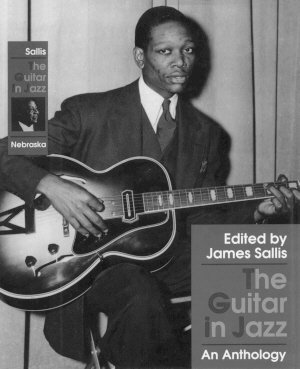
|
The
majority of the chapters in this anthology have been previously published in various other
books but James Sallis has done an excellent job in selecting some of the best. The
cover photo is very appropriate: there are significant references to Charlie
Christian in virtually every chapter of the book.
The feature article on CC is “Charlie
Christian,” a 16-page chapter by Bill Simon from the 1957 anthology The Jazz
Makers (less the original selected discography). Written before much was known
about Charles, this was one of the earliest and best-known recountings of the Charlie
Christian story. Other reprints include, also from 1957, “The
Guitar” by Joachim E. Berendt from The Jazz Book and Leonard Feather’s “The Guitar in Jazz” from The Book of Jazz.
Supplementing the
works referred to in the reviews above, there is an article on “Jazz
Guitar and Western Swing” by Michael Price.
This book review was originally
published in the 1997 Solo Flight: The Charlie Christian Newsletter # 3
© LeoValdes
Revised and updated on November 23, 2001 |
CHARLIE CHRISTIAN
By Peter Broadbent
Ashley Mark Publishing, UK; 1997; 148 pages; �15.00
Hal Leonard Publishing, Milwaukee, WI; 1997; $19.95 |
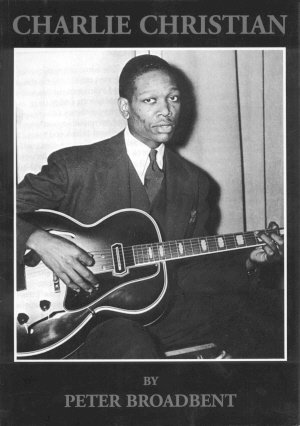
|
Peter
Broadbent has put together the most comprehensive book yet published on Charlie
Christian. There’s a chronology of his life; a discography listing the
most important issues; lots of photographs—I particularly like the photos of
many of CC’s LP and CD covers, an idea that I had planned for my own book but would
now be redundant; a bibliography and photos of some of the books and magazines on
CC; and very handy short biographies of the musicians associated with Charles.
This softcover book came out in June 1997 and is a “must-have”
for every CC fan, at least until the definitive book is published.
The early part of the biography discusses some of Charlie
Christian’s influences, including several Western Swing guitarists that may
have had some degree of impact on CC’s playing. Coincidentally, a recent
article by Jerome S. Shipment in the Annual Review of Jazz Studies 7, 1994-95
(Scarecrow Press, 1996) entitled “In Search of the Electric
Guitar: A Platonic Dialog With Music” also surveys CC’s early musical
environment. Western Swing, which was one of the prominent musics in Oklahoma and
Texas during the 1930s, has not been mentioned much in previous overviews. The
biography is well done and accurate. Broadbent correctly plays down Eddie
Durham’s alleged influence on the musical development of Charles.
There’s also an excellent chapter on the guitars of Charlie
Christian which were researched by Broadbent. Peter, incidentally, corrected me a
few months ago on the guitar that I had identified in the first newsletter as an
L-7. It is instead an extremely rare Gibson ES-250 (3rd variant) that CC used
in March 1941. It is visually identical to an electrified L-7—there’s a
photo of Tony Mottola holding the guitar on page 92 of the book. Peter also brought
to my attention Andr� R. Duchossoir’s definitive book Gibson Electrics: The
Classic Years (Hal Leonard Publishing, 1994) which contains that same photo used in a
1940 Gibson promotion leaflet. I agree with Broadbent that it was probably the very
same instrument that Charlie Christian later used, but there are photos showing CC with
the guitar on more than one occasion, so it may not have been only on loan to him from
Gibson.
Since we’re on
the subject of photographs, I’d like to comment on some of the photo captions.
The photograph on page 24 was not taken at Minton’s but at Charlie Christian’s
first Metronome All Stars session on February 7, 1940; the same comment applies to
the one with Gene Krupa on page 89. Don’t know who’s correct on the one on
page 26—I have it as a big-band Columbia recording session on March 27, 1941;
Broadbent surmises it was taken at the memorable “Solo
Flight” session.
CC playing a Vega guitar on page 66 was taken at neither the
Metronome All Star nor the sextet recording sessions at the Columbia studios on February
7, 1940, but I have no idea as to the date except that it was evidently before the summer
break of that year. According to Frank Driggs, it was taken at the Golden Gate
Ballroom in New York City; Peter Broadbent tells me that’s Jack Teagarden
partially hidden behind CC. The minor typo on page 75 should read February 5, 1941.
The top photo on page 91 is from the Paramount Theatre, but the
gig there started on April 11, 1941. Also Cootie Williams and Georgie Auld did not
join Goodman until November 1940 so it couldn’t be early 1940. The bottom photo
is not from the Paramount: another existing shot from the same gig shows the entire
sextet including Bernie Leighton and Harry Jaeger who were with Goodman during November
and December of 1940. Peter Broadbent and I agree on the rest of the photo captions.
The famous shot of Charlie Christian in the white hat (page 18) was
taken at his first studio recording date (Lionel Hampton’s session) on September 11,
1939. The uncropped image of this photo shows a very young-looking Hampton on
Charles’ right with, in the background, Ben Webster between them and Dizzy Gillespie
over Charles’ left shoulder.
A major portion of Peter Broadbent’s book consists of a discography
with one serious flaw: the omission of “Flying
Home” from the 9 September 1939 Camel Caravan aircheck. It
was issued for the first time in 1995 on a Swedish double-CD Benny Goodman’s
Golden Era: More Camel Caravans, Vol. III, Phontastic NCD 8845/8846.
I have one more quibble: the discography lists quite a few
catalog numbers that are not listed in Part Twelve (LP Records, CDs, Bibliography).
It’s difficult to identify some of the issues without a label or CD/LP title.
Incidently, catalog number 62681 is listed twice; I believe the the CBS Realm Jazz
should be 52538.
The remainder of my
comments on Peter’s book apply to the discography in detail. Unless you’re
a diehard Charlie Christian fanatic, you may want to skip the rest of this article—it
does get into a lot of nit-picky trivia.
Personnel
• 24 September 1939: The Harlem Breakfast Club session.
There was no drummer present on this Minneapolis jam session; and Oscar Pettiford is
definitely the bassist.
• 14 October 1939: “Ain’t
Misbehavin’”
Louis Armstrong is featured on trumpet and vocal with the Goodman Sextet & Orchestra.
(CC was only part of the rhythm section.)
• 31 October 1939: “Death Letter
Blues”
No drums on the mx 25510 takes.
• 25 November 1939: “St. Louis
Blues”
CC is not on this one at all.
(Only Hampton was added to the orchestra.)
• 30 December 1939: “One
O’Clock Jump”
By the Goodman orchestra with Arnold Covay on rhythm guitar—no CC.
• 20 March 1940: “Memories of
You”
This was a 22 March gig—the 20th date was a typo in Russ Conner’s book.
CC missed this gig; it was a “quintet” aircheck.
• 4 October 1940: Eddy Howard studio session.
Bill Coleman (tpt) and Bud Freeman (ts) are also on this date; Coleman and Hall are
not on “Star Dust.”
• 10 February 1941: “Flying
Home”
The Goodman orchestra is on the final chorus.
• 4 March 1941: “Solo
Flight”
Johnny Guarnieri is on piano.
• 13 March 1941: “Waitin’
for Benny” jams.
No bassist during this extraordinary jam session.
Artie Bernstein and Goodman came in later for the scheduled recording session.
(One of the tunes should have been called “Waitin’ for
Artie & Benny” instead of just “Waitin’ for
Benny”)
Cootie is not on the last three tunes of the jam.
• 5 May 1941: “Flying Home”
The Goodman orchestra is on the final chorus.
• 8 May 1941: “Stompin’ at
the Savoy”
This extremely rare, never-issued jam session recorded at Minton’s Playhouse
is not listed in Broadbent’s book.
CC plays a two-chorus solo and can also be heard on the collective improvisation which
makes up the last five choruses of the 17-chorus jam.
The other participants are said to be Rudy Williams (as), Don Byas (ts), Kermit Scott
(ts), Joe Guy (tpt), Hot Lips Page (tpt), “Tex” (pno),
Nick Fenton (b), Kenny Clarke (d).
• May 1941: The Minton’s/Monroe’s jam sessions.
It’s impossible to be certain of all the personnel, but those listed here are about
as close as you can get.
(A. Tinney and T. Miller are Allen Tinney and Taps Miller.)
CD/LP Issues
• Eleven (side 1 & the last 3 tracks on side 2) of the 47
tracks on CBS/Sony LP 56AP 674~6 are not identified as being on the 3-LP box set:
—mx WCO 26132 A, 26133 A, 26134 A from 2 Oct 1939
—WCO 26284 A & B, 26285 B, 26286 A, 26290 A from 22 Nov 1939
—three tracks (with the two “I Got Rhythm” takes
spliced together) from 24 Sep 1939
• 22 November 1939 WCO 26284 A:
Peter claims his copy has “Memories of You” on CD11.15.
“Breakfast Feud” [CO 29259-4 (2)] is on track 15 of my
copy of Le Jazz CD 11.
The inserts and booklets in both CDs list “Breakfast
Feud.”
• 2 December 1939 “AC-DC Current”:
My copy of Jazz Archives LP JA42 has the 27 November 1939 version of “AC-DC Current”
(the one with Goodman shouting “Hi-Ho, Bernstein” during
the bass solo).
• 20 December 1939 WCO 26354 (bkdn):
TPZ1017.8 should be listed under WCO 26354 A.
• 7 February 1940 WCO 26495 A:
4032.9 should be listed under WCO 26495 B.
• 19 December 1940 CO 29259- (3):
MJCD67.14 contains this take spliced with CO 29259- (4) not quite the same as
Broadbent’s CO 29259-S(a).
• 15 January 1941 CO 29512-4:
56AP676.1/4 should be listed under CO 29512-S(b).
• 15 January 1941 CO 29519-1:
465679.17 & 45144.17 should be listed under CO 29519-3.
• 3 March 1941:
“Six Appeal” is not on BEKOG14800.
• 13 March 1941: “A Smo-o-o-oth One”
a test pressing was found (circa 1980) that identified the take on MJCD74.11 as CO
29942-1.
There are also some inaccuracies as
to which takes are on the various spliced recordings that have been released of
“Benny’s Bugle,” “Breakfast
Feud,” and “Good Enough to Keep.”
[A graphic outline of the sliced issues can be found in The Spliced Recordings section on this website]
[A much-revised and better organized
edition of this book is scheduled for 2002]
This book review was originally published in the 1997 Solo Flight:
The Charlie Christian Newsletter # 3
© LeoValdes
Revised and updated on November 23, 2001 |
CHARLIE CHRISTIAN
SOLO FLIGHT
THE STORY OF
THE SEMINAL ELECTRIC GUITARIST
By Peter Broadbent
Ashley Mark Publishing, UK; 2003; 148 pages; �25.00
Hal Leonard Publishing, Milwaukee, WI; 2003; $19.95 |
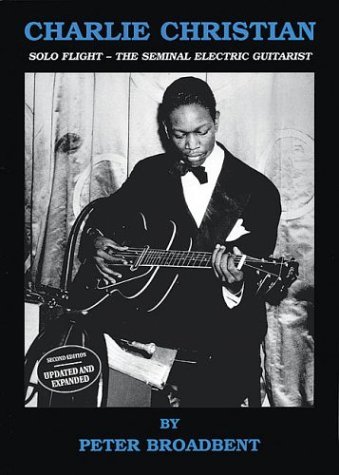
|
Peter Broadbent. “Charlie
Christian: Solo Flight – The Seminal Electric Guitarist.”
Ashley Mark; Hal Leonard. (Second Edition). 2003. USA $19.95.
Despite his importance in jazz, Charlie Christian has never, before
Broadbent’s work, been honoured with a book length biography. Broadbent
presents a chronological account over thirteen chapters, followed by eight appendices
covering such items as CC’s musical style, technical details of his guitars and
amplifiers, a bibliography and a discography. There are many illustrations,
including photographs, ephemera, reproductions of record labels, certificates and other
documents.
In evaluating any work, one should if possible take account of the
author’s intention. As far as I can tell, Broadbent does not explicitly state
what his aim is; I assume the aim was to write an authoritative account of the life
and influence of CC. But to judge a biography one might also assess its originality,
comprehensiveness, quality of the research, the author’s judgment in evaluating and
synthesizing the source material, and the coherence of the finished narrative.
It is clear that Broadbent has carried out many interviews with people
who knew CC personally, or through his music, and has reviewed documentary material and
previous literature (I believe though, although he is not explicit about this, that he has
not included details of all sources reviewed; for instance I doubt that he would
have ignored Ralph Ellison’s work, but it is not listed in the Bibliography).
Clearly there is much new material about CC that Broadbent has been
able to discover. However, I feel there are three main problems with the way the
biography is presented and was researched.
The author fails to blend into a flowing narrative the disparate
accounts of CC provided by the interviewees and documentary sources. Much of the
text consists of verbatim quotes: Broadbent states that he prefers to present his
research this way, as the interviewee’s words are more ‘powerful and
revealing.’ I would suggest this is a rhetorical comment that perhaps attempts
to defend a failure to evaluate and synthesize the various accounts. A more
effective way of telling the story would be an account that was more coherent. The
ratio of quotes to author text is too great to give a smooth narrative and makes for a
text that is uncomfortable to read. It would have been better to have summarized
more of interviews in the narrative.
Secondly, Broadbent seems to find it difficult to make judgments about
what is relevant and what is peripheral and thus on what to omit and what to include.
The choice of material is often indiscriminate. For instance, on pp. 80-81,
most of the text is taken up with extensive quotes from Goodman band members about
TWA
flights, the Steel Pier venue (including a horse act that dived into the sea), and the
Michigan State Fair – there is nothing directly about Charlie Christian: this
is background material that really could, I think, have been better dealt with by a short
summary or perhaps by omitting it altogether.
Similarly, on p. 115, there is quote from Allen Tinney that has about
three lines on CC and the rest (a whole column) is concerned with background information
on Monroe’s Uptown House that is really only of marginal importance. Yes, we
are interested in knowing what this important venue was like, but the balance of such
information with CC-specific detail seems wrong. The comments about CC by Tinney are
bland and generalized, to the effect that CC was “a very nice person,” and that
he was “serious” and a dapper dresser. I would question whether these
really were worth including.
Problems about what to include apply not only to biographical items but
also to other subject matter. Information on the symptomatology of
TB and the
technicalities of guitar amplification (even taking into account some specialist readers)
contain irrelevant detail and obscure technical language; such information would
have much better been summarized.
Many of the quotes contain statements that are virtually
unintelligible. An example is on p. 82. – a quote from Jimmy Gourley:
“I said (to
Kenny Clarke) ‘Jeez Kenny its Benny Goodman’ he’d come down because he knew
Kenny from the old days. We were sitting around talking and finally I said ‘Benny,
about Charlie Christian you know’ and Benny turned to Kenny and said ‘Charlie
was sick wasn’t he?’ Can you imagine that? It was unbelievable and I
couldn’t go on after that, but Benny was kind of a nutty guy.”
It is very difficult to understand what Jimmy Gourley could have meant.
It seems he was surprised by Goodman’s response but both the question and the
reply are so vague that one cannot really make much sense of this exchange. It may
be that the original interview with Gourley has further clues, but as it stands the quote
really is quite obscure. When the interview was conducted the interviewer should
have pressed the speaker to explain what he meant. Alternatively I would suggest
that the quote is so obscure that it might have been omitted.
There are many further examples of verbatim quotes from interviews with
sections that are almost uninterpretable, and thus, unfortunately, meaningless.
To interview people effectively requires very specialist skills; how to
pose questions, to probe for further information, to clarify answers that are vague, and
so on. The difficulties of face-face interviewing may be worse when interviewing by
telephone. These skills are called for in social research, oral history, and in
researching for biographies. Many people underestimate the degree of skill needed.
It is an extremely difficult task to try to evaluate the sometimes
conflicting and confusing accounts of CC’s life and synthesize them into a single
flowing, convincing narrative. One is inevitably almost overcome by the sheer
complexity of it all. Yet I believe this is precisely the task that the biographer
must confront. Biographies such as Daniel Epstein’s “Nat King Cole,” or the
history of Western Swing, Charles R. Townsend’s “San Antonio Rose: The
Life and Music of Bob Wills” very successfully synthesize the source material in a
completely convincing way. Each source is documented in scrupulous detail, the
narrative flows; a vivid picture of events emerges.
In general the photographs are of rather poor quality. Although
in some cases the originals are perhaps not very good, in other cases the method of
reproduction used for the book must be at fault. For example the well-known
photograph of CC leaving Oklahoma City in 1939 (on p. 71) is usually seen in a much
sharper image than in this instance. The format, font size and general design seems
to position the book as an item intended for guitarists rather than a more general musical
biography readership. It seems to fit with books such as Roger Chapman’s
“Guitar: Music . History . Players” that appeal to guitar collectors and
the like.
As well as the biography (which in a sense is the centre of the work),
Broadbent also presents an appendix on CC’s music, and a discography.
Discographies have a special importance in jazz research. Typical biographies in
what might be called the literary idiom (eg Epstein’s mentioned above) usually
contain only selective discographies that seem superficial compared to the exacting
standards of specialist jazz discographies. Usually the latter are published solely
as discographies, are comprehensive and include exhaustive details of personnel, issues,
venues, etc. There is a related form typified by works such as Edward Brooks’
“The Bessie Smith Companion” (and perhaps Ian McDonald’s “Revolution
in the Head” – a similar work on the Beatles) that present a chronological,
in-depth review of every recording by an artist. I would suggest that this kind of
approach would have been very interesting in CC’s case.
Though described as a discography, this section of Broadbent’s
book is not a complete discography in the normal sense of the word, as it lists only one
instead of every or most issues of each recording. It is rather a disappointment
that there is no full discography as there are many CC collectors who have followed with
interest the evolution of CC discographical research, starting with John Callis’s
pioneering work, through Jan Evensmo’s innovative solography format, then the
additional material published in Russ Connor’s Benny Goodman bio-discography, through
the comprehensive work of Leo Valdes in his web site.
The discussion of musical analysis presents only one extended quote
from Howard Spring’s work. Even a superficial review of this topic should, I
think, at least acknowledge the wide range of published analysis of CC’s playing
(including for instance, Schuller, Finkelman, and Marshall), and attempt some comparative
evaluation of each. It is inadequate to simply quote a source without any comment,
and particularly to refer to only one such source.
I think this is a significant fault because, as suggested earlier, an
integral part of a biography of CC should be an assessment of his historical significance.
Musical analysis of CC’s innovations, his relationship to Bop, and other
technical issues, would I think form an essential element of an assessment.
There is much interesting and valuable information presented in this
biography and clearly the author has carried out a great deal of original research.
I am sure that many people interested in CC’s life and music will want to read the
book and will find it of interest. Indeed, any CC fan would find it essential
reading. Unfortunately the useful material is rather marred by the presentation and
frequent irrelevant information.
Yet Broadbent has in the course of his research into CC done much for
which CC fans will be eternally grateful. Peter’s tenacity enabled him to acquire the
famous lost “Stompin’ at the Savoy” recording. Through his
generosity, that recording was published, rather than kept privately and denied to the
many fans who had known of its existence. Although I do not know full details of
Peter’s role in the collation of material for the Columbia Legacy issue, I suspect
that he played a key part in researching the archive and ultimately in making sure that,
again, the priceless unreleased takes were finally published for everyone to enjoy.
It is much easier to criticize a book than to write one oneself.
Although few critics acknowledge this point, it is undoubtedly true – I suspect that
many critics have not themselves successfully produced works of similar complexity to
those they evaluate. As one who has considered writing a book on CC (but never risen
to the challenge), I am certainly aware of this irony. At the same time, any reader
of a work surely has an opinion and may reasonably express it, provided it is supported by
some evidence and reasoned argument. My opinions expressed here are purely my own,
and every reader will have their own. I hope though that I have given a balanced
evaluation of this particular work.
Reviewed by CLIVE DOWNS |
© LeoValdes – 12 July 2004
VIDEO REVIEWS
SOLO FLIGHT
THE GENIUS OF CHARLIE CHRISTIAN
written & directed by Gary Don
Rhodes
V.I.E.W. Video 1353; 1997; $19.95 |
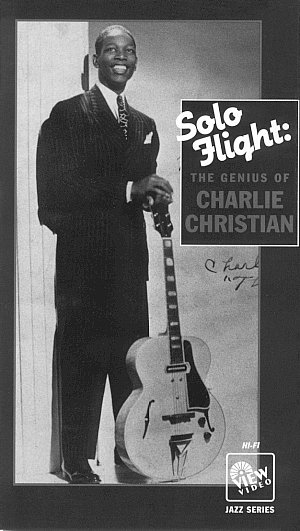
|
Gary Don
Rhodes’ film on Charlie Christian was finally released on videocassette late last
year. The filmmaker from Norman, Oklahoma, has done a considerable amount of
research on Charles’ life and times in Oklahoma City and on jazz in OKC during its
heyday—probably more than anyone else. This video is a re-edited version of the
original film that premiered to a live audience at the Fannin County Museum of History in Bonham,
Texas, on April 20, 1992 to raise money for the Texas historical marker now at Charlie
Christian’s grave site. Exactly a month later the original was telecast over
Oklahoma PBS station OETA.
This thirty-one minute documentary presents CC’s life, his
influences, and the considerable impact that he had on the history of jazz.
The influence that he had on the racial desegragation in jazz, especially before he gained
national prominence, is well covered. Since there is no extant movie footage of CC,
the narration is backed by many photos of Charles, his fellow musicians, and OKC’s
Second Street area (both from the 1930s and the present day) where he grew up and played
in the local clubs. Rhodes was wise not to film his work in color—it
comes together with the featured photographs much better this way.
Gary starts his film with an ingenious opening: the sextet’s
Carnegie Hall broadcast coming from a vintage radio. Film time is shared just about
equally by John Jones’ narrative and more than a dozen interviews with people
who knew Charles in OKC and Bonham. The updated version has added interviews with
“legendary jazz vibraphonist” Lionel Hampton and “legendary jazz
guitarist” Herb Ellis. Throughout the video, the recordings of Charlie
Christian can be heard in the background.
Although
Charles’ daughter was very young at the time and moved away from the OKC area before
her father joined Goodman, I would have liked to have seen an interview with Billie Jean
Christian Johnson—she could have given a broader insight by discussing later events
(especially her close relationship with her uncle, Clarence) and telling about the honors
she has accepted on her father’s behalf. There is a wonderful interview with
her mother, Margretta Christian Downey, though.
Incidently, Rhodes had no input on the notes on the back of the video
box cover which, to his consternation and embarrassment, incorrectly lists Charlie
Christian’s year of birth. If you haven’t seen Gary’s film yet, you
need to sit down and order a copy of this videocassette ASAP.
This video review was originally
published in the 1997 Solo Flight: The Charlie Christian Newsletter # 3
© LeoValdes
Revised and updated on November 23, 2001 |
[ Home ]
[ News/Updates ] [ Solography ] [ Discography ] [ Chronology ] [ Photo Gallery ] [ Transcriptions ] [ Ancillary Transcriptions ] [ Bibliographies ] [ CD Reviews ] [ Book-Video Reviews ] [ SplicedTracks ] [ Links ]
|